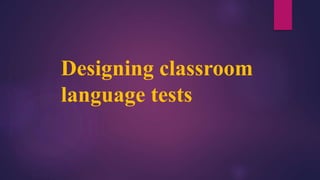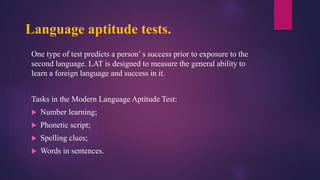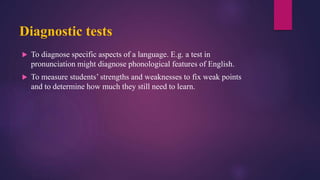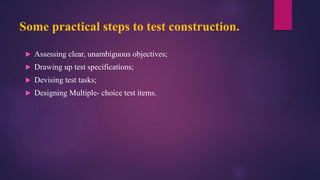Designing classroom language tests
- 2. 1) What is the purpose of the test? 2) What are the objectives of the test? 3) How will the test specifications reflect both the purpose and the objectives? 4) How will the test tasks be selected and the separate items arranged?
- 4. Language aptitude tests. One type of test predicts a personŌĆÖ s success prior to exposure to the second language. LAT is designed to measure the general ability to learn a foreign language and success in it. Tasks in the Modern Language Aptitude Test: ’üĄ Number learning; ’üĄ Phonetic script; ’üĄ Spelling clues; ’üĄ Words in sentences.
- 5. Proficiency Tests To measures a learnerŌĆÖ s level of language that includes all aspects such as listening, speaking, reading, grammar and writing (TOEFL; IELTS).
- 6. Placement tests. ’üĄ A test to check the academic skills of entering students because the may have different skill levels; ’üĄ To place students in class according to their level.
- 7. Diagnostic tests ’üĄ To diagnose specific aspects of a language. E.g. a test in pronunciation might diagnose phonological features of English. ’üĄ To measure studentsŌĆÖ strengths and weaknesses to fix weak points and to determine how much they still need to learn.
- 8. Achievement test. The specifications for an achievement test should be determined by: ’üĄ The objectives of the lesson, unit, or course being assessed; ’üĄ The relative importance (or weight) assigned to each objective; ’üĄ The tasks employed in classroom lessons during the unit of time; ’üĄ Practicality issues, such as the time frame for the test and turnaround time; ’üĄ The extent to which the test structure lends itself to formative washback.
- 10. To evaluate academic abilities related to syllabus or classroom lesson, curriculum within a particular time. Achievement tests: ’üĄ Short-term (during certain period) ’üĄ Long-term (to check progress over the entire course. It can be structured as quizzes and be formulated as presentation, research, projects)
- 11. The product of the design stage is a design statement, which is a document that includes the following components: ’üĄ A description of the purpose(s) of the test; ’üĄ A description of the TLU domain and task types; ’üĄ A description of the test takers for whom the test is intended; ’üĄ A definition of the constructs to be measured; ’üĄ A plan for evaluating the qualities of usefulness; ’üĄ An inventory of required and available resources and a plan for their allocation and management. Bachman & Palmer
- 12. Some practical steps to test construction. ’üĄ Assessing clear, unambiguous objectives; ’üĄ Drawing up test specifications; ’üĄ Devising test tasks; ’üĄ Designing Multiple- choice test items.
- 13. Assessing clear, unambiguous objectives.
- 14. Drawing up test specifications. Your specifications will simply comprise: ’üĄ A broad outline of the test; ’üĄ What skills u will test; ’üĄ What the items will look like.
- 15. ’üĄ Outline of the test and skills to be included. Because of the constraints of your curriculum, your unit test must take no more than 30 minutes. This is an integrated curriculum, so you need to test all 4 skills, and this 30 mins test should be divided equally in time among them.
- 16. Item types and tasks. It is surprising that there are a limited number of modes of eliciting responses (i.e. prompting) and of responding on tests of any kind. Consider the options: the test prompt can be oral (students listen) or written (student reads). But some complexity is added when you realize that the types of prompts in each case vary widely, and within each response mode, there are a number of options, for example like these.
- 17. These informal, classroom-oriented specifications give you an indication of: ’üĄ The topics (objectives) you will cover; ’üĄ The implied elicitation and response formats for items; ’üĄ The number of items to be allocated for each.

















